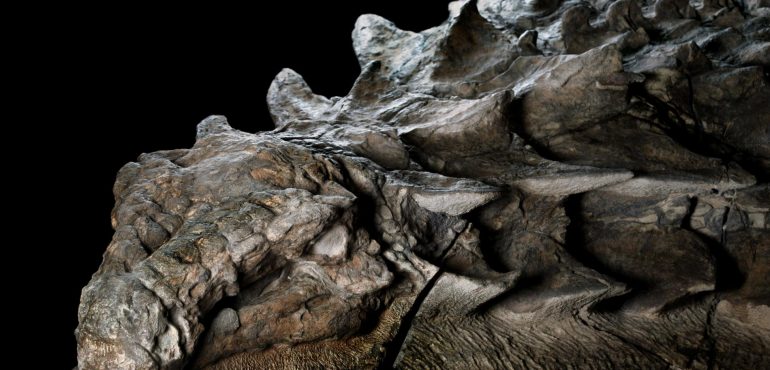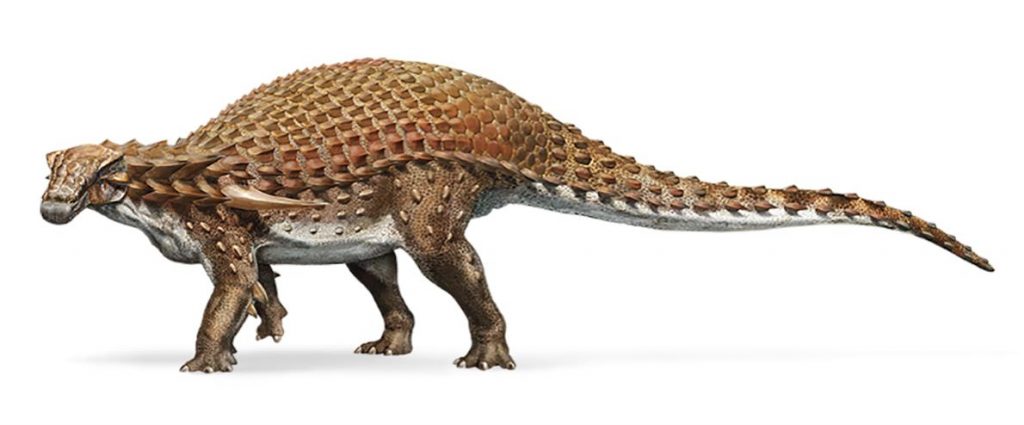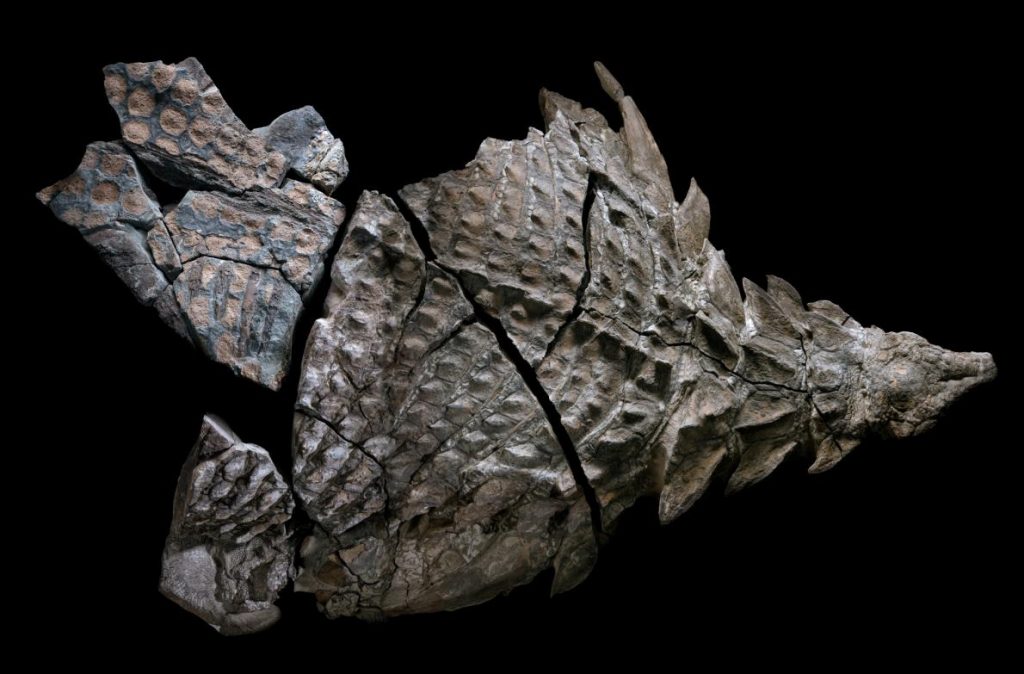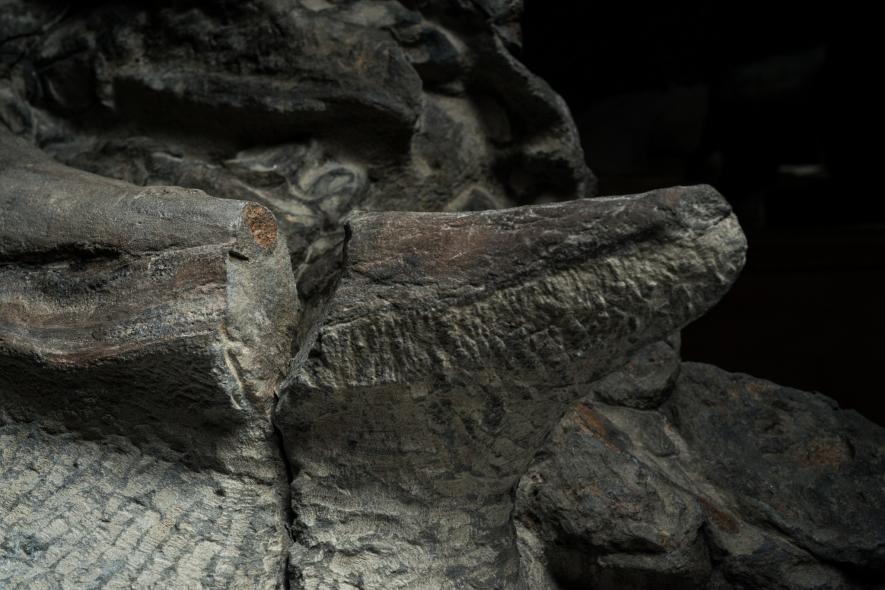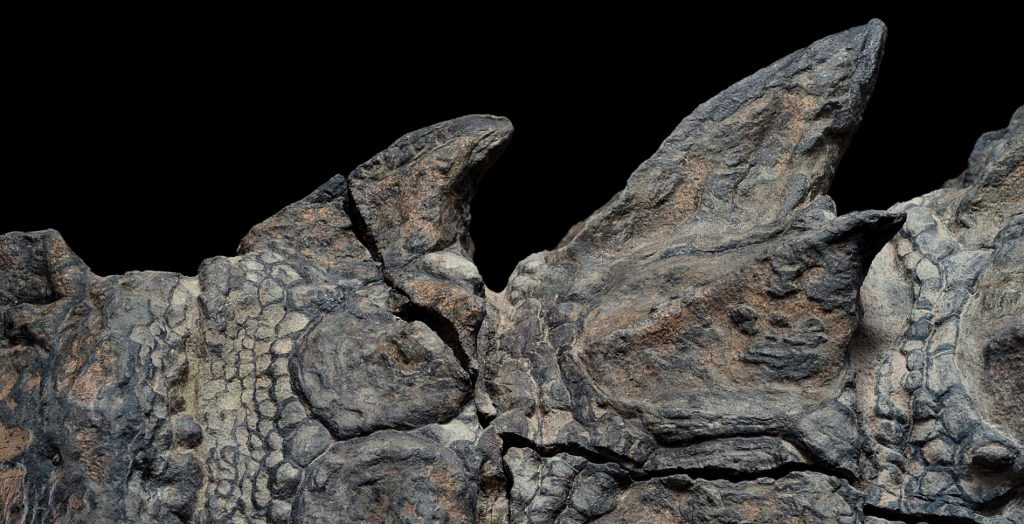On the afternoon of March 21, 2011, a heavy-equipment operator named Shawn Funk was carving his way through the earth, unaware that he would soon meet a dragon.
That Monday had started like any other at the Millennium Mine, a vast pit some 17 miles north of Fort McMurray, Alberta, operated by energy company Suncor. Hour after hour Funk’s towering excavator gobbled its way down to sands laced with bitumen—the transmogrified remains of marine plants and creatures that lived and died more than 110 million years ago. It was the only ancient life he regularly saw. In 12 years of digging he had stumbled across fossilized wood and the occasional petrified tree stump, but never the remains of an animal—and certainly no dinosaurs.
But around 1:30, Funk’s bucket clipped something much harder than the surrounding rock. Oddly colored lumps tumbled out of the till, sliding down onto the bank below. Within minutes Funk and his supervisor, Mike Gratton, began puzzling over the walnut brown rocks. Were they strips of fossilized wood, or were they ribs? And then they turned over one of the lumps and revealed a bizarre pattern: row after row of sandy brown disks, each ringed in gunmetal gray stone.
“Right away, Mike was like, ‘We gotta get this checked out,’ ” Funk said in a 2011 interview. “It was definitely nothing we had ever seen before.”
Royal Tyrrell Museum technician Mark Mitchell slowly frees the nodosaur’s foot and scaly footpad from the surrounding rock. Mitchell’s careful work will preserve for years to come the animal’s enigmatic features.
Nearly six years later, I’m visiting the fossil prep lab at the Royal Tyrrell Museum in the windswept badlands of Alberta. The cavernous warehouse swells with the hum of ventilation and the buzz of technicians scraping rock from bone with needle-tipped tools resembling miniature jackhammers. But my focus rests on a 2,500-pound mass of stone in the corner.
At first glance the reassembled gray blocks look like a nine-foot-long sculpture of a dinosaur. A bony mosaic of armor coats its neck and back, and gray circles outline individual scales. Its neck gracefully curves to the left, as if reaching toward some tasty plant. But this is no lifelike sculpture. It’s an actual dinosaur, petrified from the snout to the hips.
The more I look at it, the more mind-boggling it becomes. Fossilized remnants of skin still cover the bumpy armor plates dotting the animal’s skull. Its right forefoot lies by its side, its five digits splayed upward. I can count the scales on its sole. Caleb Brown, a postdoctoral researcher at the museum, grins at my astonishment. “We don’t just have a skeleton,” he tells me later. “We have a dinosaur as it would have been.”
For paleontologists the dinosaur’s amazing level of fossilization—caused by its rapid undersea burial—is as rare as winning the lottery. Usually just the bones and teeth are preserved, and only rarely do minerals replace soft tissues before they rot away. There’s also no guarantee that a fossil will keep its true-to-life shape. Feathered dinosaurs found in China, for example, were squished flat, and North America’s “mummified” duck-billed dinosaurs, among the most complete ever found, look withered and sun dried.
Paleobiologist Jakob Vinther, an expert on animal coloration from the U.K.’s University of Bristol, has studied some of the world’s best fossils for signs of the pigment melanin. But after four days of working on this one—delicately scraping off samples smaller than flecks of grated Parmesan—even he is astounded. The dinosaur is so well preserved that it “might have been walking around a couple of weeks ago,” Vinther says. “I’ve never seen anything like this.”
A poster for the movie Night at the Museum hangs on the wall behind Vinther. On it a dinosaur skeleton emerges from the shadows, magically brought back to life.
The remarkable fossil is a newfound species (and genus) of nodosaur, a type of ankylosaur often overshadowed by its cereal box–famous cousins in the subgroup Ankylosauridae. Unlike ankylosaurs, nodosaurs had no shin-splitting tail clubs, but they too wielded thorny armor to deter predators. As it lumbered across the landscape between 110 million and 112 million years ago, almost midway through the Cretaceous period, the 18-foot-long, nearly 3,000-pound behemoth was the rhinoceros of its day, a grumpy herbivore that largely kept to itself. And if something did come calling—perhaps the fearsome Acrocanthosaurus—the nodosaur had just the trick: two 20-inch-long spikes jutting out of its shoulders like a misplaced pair of bull’s horns.
The western Canada that this dinosaur knew was a very different world from the brutally cold, windswept plains I encountered this past autumn. In the nodosaur’s time, the area resembled today’s South Florida, with warm, humid breezes wafting through conifer forests and fern-filled meadows. It’s even possible that the nodosaur gazed out on an ocean. In the early Cretaceous, rising waters carved an inland seaway that blanketed much of what’s now Alberta, its western shore lapping against eastern British Columbia, where the nodosaur may have lived. Today those ancient seabeds lie buried under forests and rolling fields of wheat.
One unlucky day this landlubbing animal ended up dead in a river, possibly swept in by a flood. The belly-up carcass wended its way downriver—kept afloat by gases that bacteria belched into its body cavity—and eventually washed out into the seaway, scientists surmise. Winds blew the carcass eastward, and after a week or so afloat, the bloated carcass burst. The body sank back-first onto the ocean floor, kicking up soupy mud that engulfed it. Minerals infiltrated the skin and armor and cradled its back, ensuring that the dead nodosaur would keep its true-to-life form as eons’ worth of rock piled atop it.
The creature’s immortality hinged on each link in this unlikely chain of events. If it had drifted another few hundred feet on that ancient sea, it would have fossilized beyond Suncor’s property line, keeping it entombed. Instead Funk stumbled upon the oldest Albertan dinosaur ever found, frozen in stone as if it had gazed upon Medusa.
“That was a really exciting discovery,” says Victoria Arbour, an armored-dinosaur paleontologist at Canada’s Royal Ontario Museum. Arbour has seen the fossil at various stages of preparation, but she’s not involved in its study. “It represents such a different environment from today and such a different time, and it has great preservation.” (Arbour has begun studying a similarly well preserved ankylosaur found in Montana in 2014, much of which remains hidden within a 35,000-pound block of stone. On May 10, Arbour and her colleague David Evans published a description of the Montana ankylosaur, naming it Zuul crurivastator—"Zuul, destroyer of shins"—after the monster in the film Ghostbusters.)
The Canadian specimen literally defies words, in more ways than one. As this article went to press, museum staff were finalizing the creature’s scientific description and hadn’t yet settled on a common name for it. (“Mrs. Prickley,” a reference to a Canadian sketch comedy character, didn’t stick.) But already the fossil is providing new insights into the structure of nodosaurs’ armor. Reconstructing armor usually requires educated guesswork, as the bony plates, called osteoderms, scatter early in the decaying process. Not only did the osteoderms on this nodosaur preserve in place, but so did traces of the scales in between.
What’s more, sheaths once made of keratin—the same material that’s in human fingernails—still coat many of the osteoderms, letting paleontologists see precisely how these sheaths exaggerated the armor’s size and shape. “I’ve been calling this one the Rosetta stone for armor,” says Donald Henderson, curator of dinosaurs at the Royal Tyrrell Museum.
Freeing this Rosetta stone from its rocky tomb, however, proved a herculean task.
After word of the discovery raced up the ladder at Suncor, the company quickly notified the Royal Tyrrell Museum. Henderson and Darren Tanke, one of the museum’s veteran technicians, scrambled aboard a Suncor jet and flew to Fort McMurray. Suncor excavators and museum staff chipped away at the rock in 12-hour shifts, shrouded in dust and diesel fumes.
They eventually whittled it down to a 15,000-pound rock containing the dinosaur, ready to be hoisted out of the pit. But with cameras rolling, disaster struck: As it was lifted, the rock shattered, cleaving the dinosaur into several chunks. The fossil’s partially mineralized, cakelike interior simply couldn’t support its own weight.
Tanke spent the night devising a plan to save the fossil. The next morning Suncor personnel wrapped the fragments in plaster of paris, while Tanke and Henderson scrounged for anything to stabilize the fossil on the long drive to the museum. In lieu of timbers, the crew used plaster-soaked burlap rolled up like logs.
The MacGyver-like plan worked. Some 420 miles later the team reached the Royal Tyrrell Museum’s prep lab, where the blocks were entrusted to fossil preparator Mark Mitchell. His work on the nodosaur has required a sculptor’s touch: For more than 7,000 hours over the past five years, Mitchell has slowly exposed the fossil’s skin and bone. The painstaking process is like freeing compressed talcum powder from concrete. “You almost have to fight for every millimeter,” he says.
Mitchell’s fight is nearly over, but it will take years, if not decades, to fully understand the fossil he uncovers. Its skeleton, for example, remains mostly obscured in skin and armor. In some ways it’s almost too well preserved; reaching the dinosaur’s bones would require destroying its outer layers. CT scans funded by the National Geographic Society have revealed little, as the rock remains stubbornly opaque.
For Vinther the nodosaur fossil’s most revolutionary features may lie at its smallest scale: microscopic remnants of its original coloration. If he successfully reconstructs its distribution, he could help reveal how the dinosaur navigated its environment and used its pronounced armor.
“This armor was clearly providing protection, but those elaborated horns on the front of its body would have been almost like a billboard,” he says. This advertisement could have helped woo mates or intimidate rivals—and may have stood out against a backdrop of rouge. Chemical tests of the dinosaur’s skin have hinted at the presence of reddish pigments, contrasting with the horns’ markedly light coloration.
In May the Royal Tyrrell Museum unveils the nodosaur as the centerpiece of a new exhibit of fossils recovered from Alberta’s industrial sites. Now the public is marveling at what has wowed scientists for the past six years: an ambassador from Canada’s distant past, found in a moonscape by a man with an excavator.
National Geographic, Orginal Article

